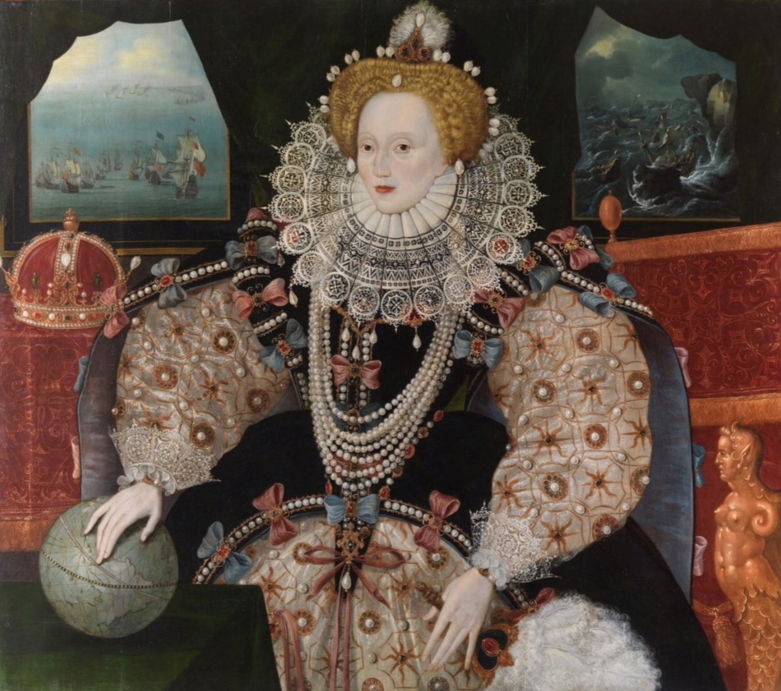We do not know when exactly pearls were first treasured in the East but Pliny (AD33/34-78) comments on their appearance in the 61BC celebrations following the victory of Pompey over Mithridates VI of Pontus in the Third Mithridatic War (73-63BC). The opposing sides in the long-running war each commanded large groups of allies and the entire east of the Mediterranean and large parts of Asia were embroiled in the conflict. The ensuing festivities were famous for their lavish displays of pearls and gemstones, and included thirty-three pearl crowns and images fashioned in pearls, including Pompey’s own portrait, but Pliny did not approve of this ostentation, no matter how significant the triumph was for the Roman Republic. He was not only critical of pearls flaunted on a magnificent scale, he did not like two or three pearls worn dangling from the ears of ladies jangling together as they moved. He regarded Lollia Paulina, third wife of Caligula, as vulgar for adorning herself with emeralds and pearls which she wore on her head, neck, ears, wrists and fingers. He alleged that she carried the receipts to support her claim that the jewels were worth 40m sesterces. These personal snipes should probably be seen in the context of Pliny’s views on Rome’s exorbitant spending on Ancient India’s ‘useless’ pepper and pearls. Alas, there are no surviving remnants from the Mithridatic War victory celebrations.
Treasure of an oyster: Tales of natural pearls | Part II

Closer to our own times there is plentiful proof of the role played by pearls in the life of another high-profile ruler, Elizabeth I. Natural pearls were certainly prevalent in the 16th century but the Queen was uniquely placed as she could wear them in abundance, as seen in the portraits capturing the official and personal events of her reign. The shimmering, moon-like nature of pearls aligns them with purity, chastity, beauty and femininity – virtues with which Elizabeth strongly associated and which she consistently sought to project. No other monarch before or since has used pearls to the same extent. As a young princess, Elizabeth was quiet and modest, and she had experienced an uneasy childhood. At the age of two her mother was executed and she was declared illegitimate, and later during the reign of her half-sister Mary she spent nearly a year in prison for supporting Protestant dissenters. When Queen, her style of rule was cautious, considered and calm, but in her portraits her strength, steadfastness and supremacy are to the fore, and in these paintings she wears pearls in profusion.

The Phoenix portrait, oil on panel by Nicholas Hilliard (c. 1547-1619) dates from circa 1575 and is named for the phoenix jewel Elizabeth wears at her chest. The phoenix symbolising endurance and eternal life reinforces Elizabeth’s uniqueness and the sense of longevity. Below her ruff she wears a gold necklace set with gemstones and pearls, from its central motif a pear-shaped pearl is suspended. A Tudor rose sits at the centre of a longer and bigger necklace in a similar design and around her waist Elizabeth wears a single row pearl girdle. Her dress is decorated with an all-over leaf design in gold, each one outlined in gold thread along which pearls are set. A single pearl sits at Elizabeth’s forehead and pearls feature in the band holding her auburn curls in place.

Thirteen years later the realm was reeling from the threat of the Spanish Armada, the most famous and potentially catastrophic engagement of Elizabeth’s reign. A commemorative portrait of the Queen, executed soon after the event, is rich in symbolism and narratives: the Spanish fleet wrecked off the coast of either Scotland or Ireland, an imperial crown, a globe and, a wealth of pearls. They are set into the sleeves and the skirt of her dress, several long ropes of large pearls are draped over her bodice, her hair is framed by twenty-two pearls, her diadem is topped by a pearl and another hangs just above her forehead. The large pearl hanging from a pink jewelled ribbon could easily be overlooked, Elizabeth wears a pearl in this fashion in other portraits and it is thought that the vogue originated from within the Medici court.

It is possible that the strings of pearls worn by the Queen in the Armada portrait had belonged to Mary Queen of Scots. In 1567 and 1568 John Wood and Nicoll Elphinstone, supporters of Regent Moray, Mary’s Protestant half-brother, were in England attempting to sell Mary’s jewels and pearls to raise funds to govern Scotland and restrain Mary’s supporters. In April 1568 a large quantity of pearls was sold to Elizabeth, these pearls were said to been given to Catherine de’Medici as a wedding present by Pope Clement VII. Pierre de Bourdeille, a French soldier and biographer, recounts that Catherine gave them to Mary and that he saw her wearing them. Further, the French diplomat Jacques Bochetel de la Forest described what are thought to be the same pearls in detail in various letters, some he said were as large as muscady nuts (or nutmegs). It is reported that Elizabeth paid 12,000 crowns for the pearls and that prior to the sale she viewed them in Berwick in an arranged audience with Elphinstone and in the presence of the Earls of Leicester and Pembroke. Mary’s escape from Lochleven Castle and her arrival in England, in May 1568, brought further sales of her jewels to an end with Elizabeth needing to steer a more neutral course and she actively tried to prevent others from making purchases too.

Elizabeth I would have been around 70 years old in The Rainbow portrait, dating to circa 1600-1603, although its recent restoration indicates that the painting might have been executed posthumously. It is subscribed NON SINE SOLUS/IRIS – no rainbow without the sun – the Queen being the sun, the source of light, wisdom and the harbinger of peace. Given her age at the time, either the Queen wanted to be portrayed as a youthful beauty or it was assumed she did. This is an idealised version of the monarch, with tightly curled thick hair and a smooth, dewy complexion. We know that in reality in her later years Elizabeth wore a wig to cover her grey hair, and that following a bout of smallpox in 1562 her face bore residual marks and scars, which were further exacerbated in appearance by the makeup she wore to cover them. The Rainbow portrait artist was hitherto unknown but he is now thought to be John de Critz, the Flemish artist and son of a goldsmith who was appointed Serjeant Painter to James I in 1603. A bill for portrait alterations made by de Critz found in the archives of Hatfield House, where the portrait resides, corresponds with those found during the restoration. Much of the painting’s symbolism is clear – the cloak featuring eyes and ears representing the all-seeing, all-hearing reach of the Queen and her network, along with her own wisdom, and the serpent winding around her left arm and to the fore in the portrait, stands for shrewd acumen. And, of course her pearls, sending a strong message about chastity, are at her wrist and neck and cascading down her bodice, they decorate the edges of her transparent veil and cloak and pear-shaped pearls are suspended within her hair. The individual pearls of the knotted string are enormous, whether they were truly this size or not is impossible to determine, and while many of Elizabeth’s jewels feel thoroughly antique to us there is a familiarity in this almost casual styling. We naturally have to speculate on how the Queen came to be wearing this tremendous string of pearls. We know that when Robert Dudley died in 1588 he left 600 pearls to the Queen, but we have no record of what happened to them.

Ultimately Elizabeth had to leave her pearls behind. Her marble effigy in the Lady Chapel of Westminster Abbey acknowledges for posterity her remarkable and enduring relationship with the gem – she wears a long pearl necklace, earrings in the form of large pear-shaped pearl pendants, a pearl-ornamented stomacher and broad pearl medallions on her shoe-bows. James I commissioned the Antwerp sculptor Maximilian Colt to create the marble effigy in the early years of his reign and although now devoid of colour John de Critz was responsible for painting the figure.
